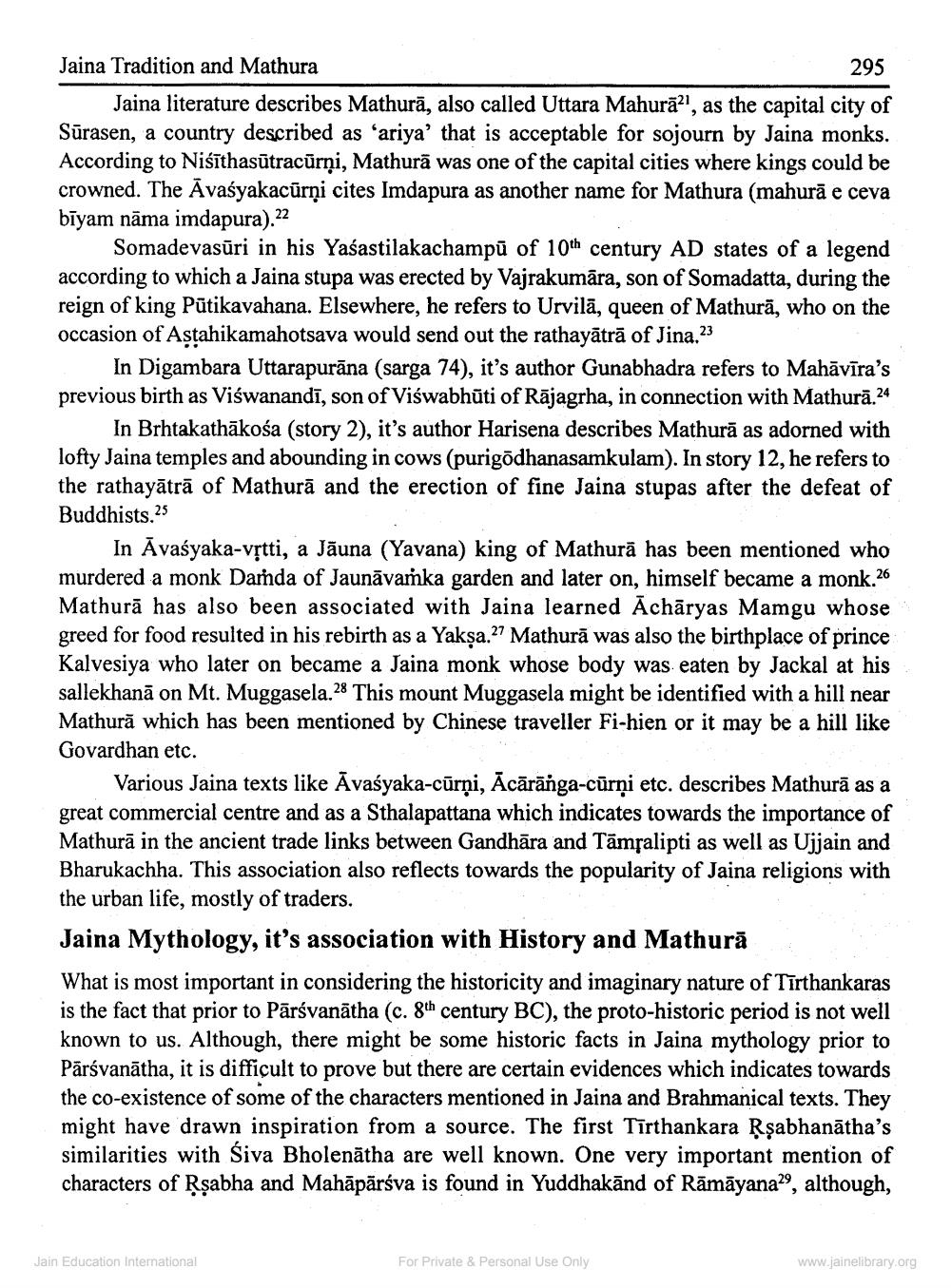________________
Jaina Tradition and Mathura
295 Jaina literature describes Mathurā, also called Uttara Mahurā?!, as the capital city of Sūrasen, a country described as 'ariya' that is acceptable for sojourn by Jaina monks. According to Nisīthasūtracūrni, Mathurā was one of the capital cities where kings could be crowned. The Āvasyakacūrņi cites Imdapura as another name for Mathura (mahurā e ceva bīyam nāma imdapura).22
Somadevasūri in his Yaśastilakachampū of 10th century AD states of a legend according to which a Jaina stupa was erected by Vajrakumāra, son of Somadatta, during the reign of king Pūtikavahana. Elsewhere, he refers to Urvilā, queen of Mathurā, who on the occasion of Astahikamahotsava would send out the rathayātrā of Jina.23
In Digambara Uttarapurāna (sarga 74), it's author Gunabhadra refers to Mahāvīra's previous birth as Viswanandī, son of Viswabhūti of Rājagrha, in connection with Mathurā.24
In Brhtakathākośa (story 2), it's author Harisena describes Mathurā as adorned with lofty Jaina temples and abounding in cows (purigodhanasamkulam). In story 12, he refers to the rathayātrā of Mathurā and the erection of fine Jaina stupas after the defeat of Buddhists.25
In Avaśyaka-vștti, a Jāuna (Yavana) king of Mathurā has been mentioned who murdered a monk Damda of Jaunāvaṁka garden and later on, himself became a monk.26 Mathurā has also been associated with Jaina learned Achāryas Mamgu whose greed for food resulted in his rebirth as a Yaksa.27 Mathurā was also the birthplace of prince Kalvesiya who later on became a Jaina monk whose body was eaten by Jackal at his sallekhanā on Mt. Muggasela.28 This mount Muggasela might be identified with a hill near Mathurā which has been mentioned by Chinese traveller Fi-hien or it may be a hill like Govardhan etc.
Various Jaina texts like Āvaśyaka-cūrņi, ācārānga-cūrņi etc. describes Mathurā as a great commercial centre and as a Sthalapattana which indicates towards the importance of Mathurā in the ancient trade links between Gandhāra and Tāmsalipti as well as Ujjain and Bharukachha. This association also reflects towards the popularity of Jaina religions with the urban life, mostly of traders. Jaina Mythology, it's association with History and Mathurā What is most important in considering the historicity and imaginary nature of Tīrthankaras
the fact that prior to Pārsvanātha (c. 8th century BC), the proto-historic period is not well known to us. Although, there might be some historic facts in Jaina mythology prior to Pārsvanātha, it is difficult to prove but there are certain evidences which indicates towards the co-existence of some of the characters mentioned in Jaina and Brahmanical texts. They might have drawn inspiration from a source. The first Tīrthankara Rşabhanātha's similarities with Śiva Bholenātha are well known. One very important mention of characters of Rsabha and Mahāpārsva is found in Yuddhakānd of Rāmāyana29, although,
Jain Education International
For Private & Personal Use Only
www.jainelibrary.org




